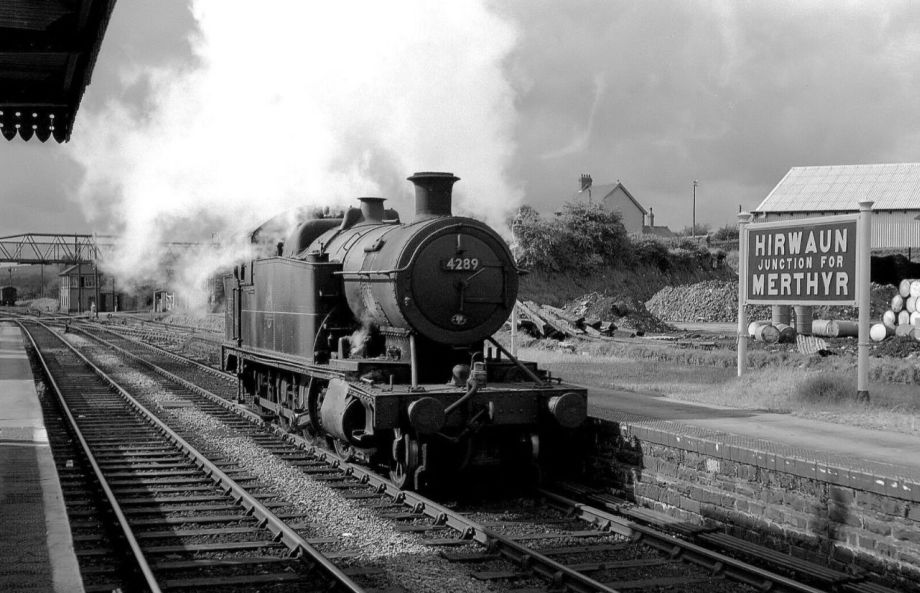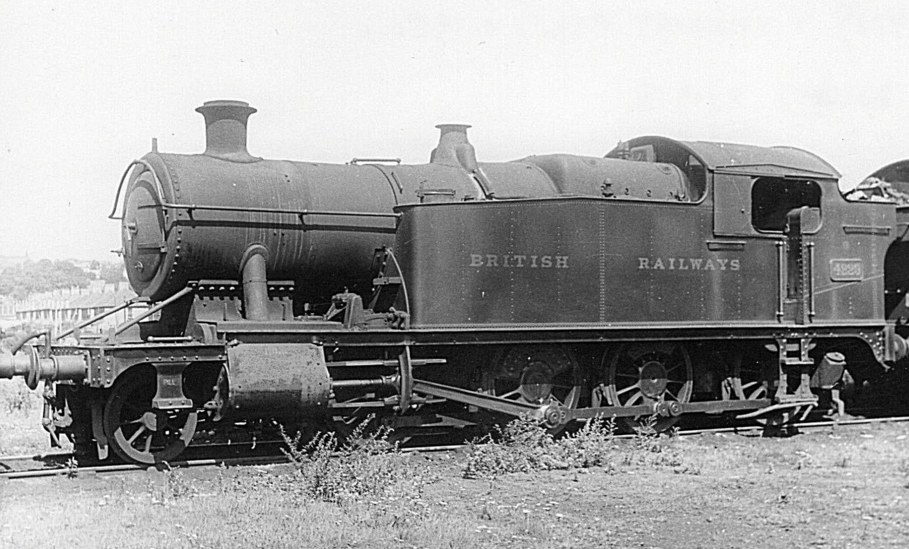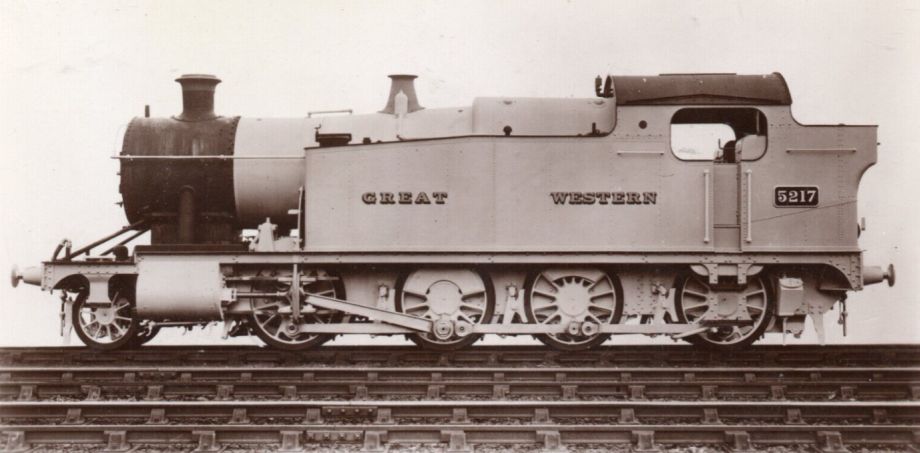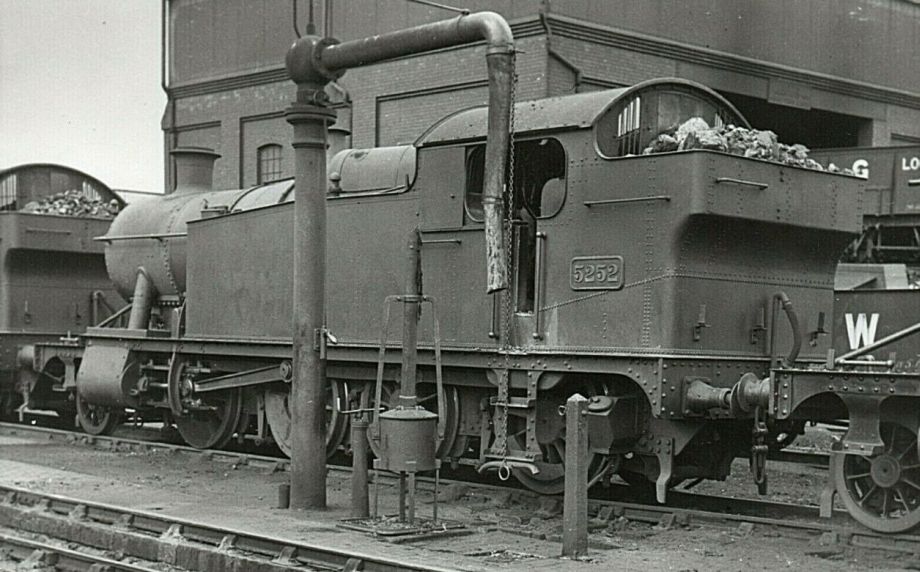| Section Page | Previous Page | Next Page |
The Great Western's heavy tanks
|
| 4238 on ECS duties at Paddington, 15 August 1931 | 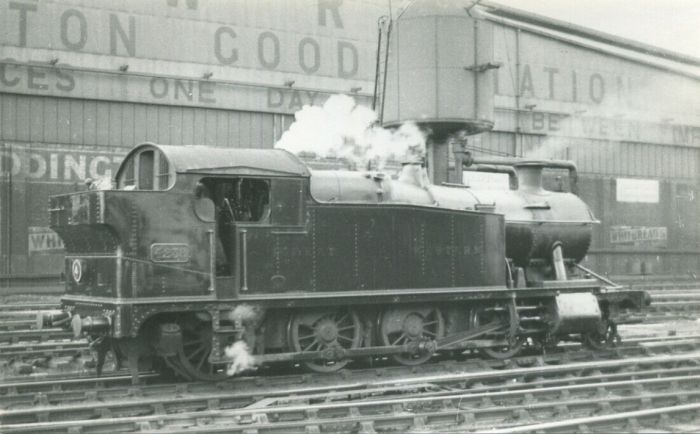 |
Preserved 4247 at Toddington on the Gloucestershire Warwickshire Railway, in post-WWII GWR livery. Image copyright Phil Scott, and licenced for use under Wikimedia Creative Commons
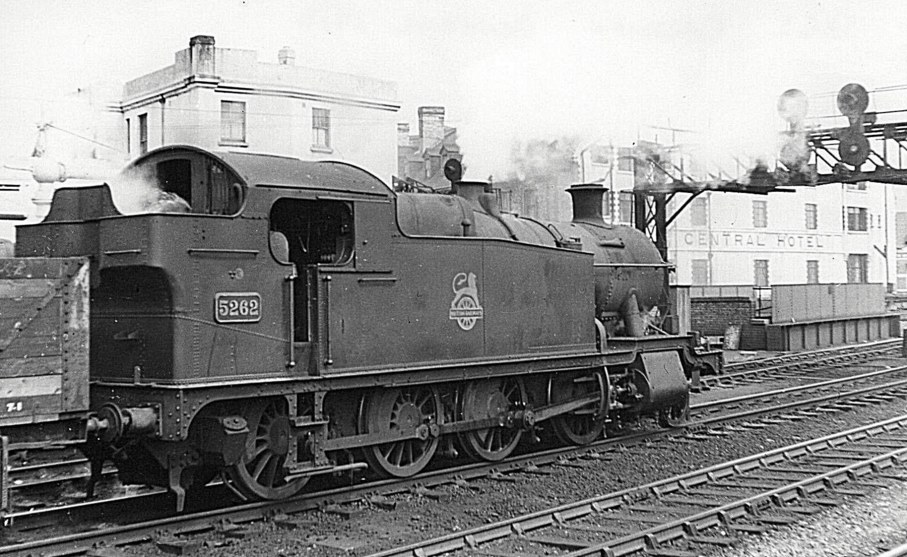
5262 at Cardiff, 1956
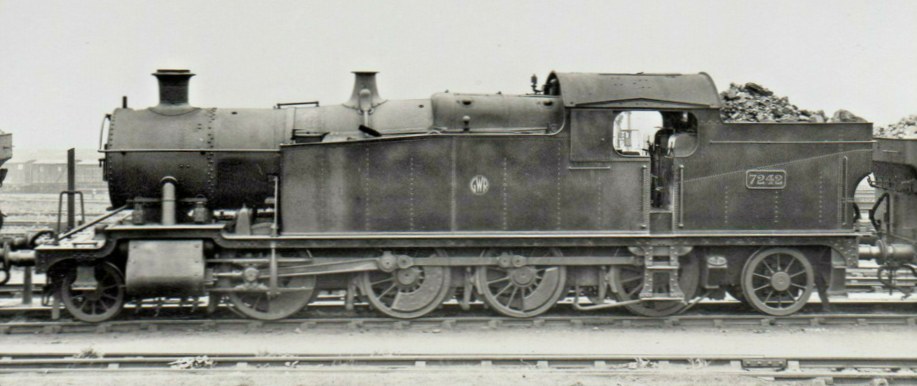
7242 in shirtbutton livery
Introduction
With building spanning 30 years and a service life of over 60, it is only to be to be expected that design changes were made during the service of these heavy tank engines. Evolution is bound to take place with the passage of time.
The first releases of the new, eagerly awaited, at least by the GW fraternity, Hornby models of these engines were released in late Spring of 2013 and it is probable that many will undergo a change of identity once they fall into the hands of modellers. With this in mind it was felt that a few notes of the differences might save a few 'red faces', however, as always a good photograph, at the right date, of your chosen prototype is the only sure way.
From the photos published in the model press and from a quick look in their show case at it would appear that Hornby have 'got it about right'.
The 2-8-0Ts
The prototype, 4201, remained the sole example for a couple of years after which batches of 10 or 20 engines appeared most years from 1912 to 1930, with a few more being built added in 1940.
| Numbers | Date | Notes |
| 4201 | 1911 | A square short bunker and no topfeed, Churchward taper buffers, 18½" diameter cylinders, brass number plates. Parallel chimney. |
| 4202–61 | 1912–17 | Extended bunker of typical GW design with the flare at the top, tall safety valve bonnet, topfeed, square drop end with inside steam pipe to cylinders, straight footplate, 4 bars to rear cab look-outs, parallel chimney. Churchward taper buffers. |
| 4200, 4262–99, 5200–04 |
1919–23 | Bunker further extended with distance piece on the rear buffer beam, cast iron chimney *, Churchward taper buffers (except 4200 which had Collett taper buffers), 4286 onwards cast iron number plates. (The earlier engines were slowly brought to this standard.) * Chimneys probably varied in styles in the late 1920s and early 1930s – see 4286, for example. |
| 5205–74 | 1923–26 | Outside steam pipe to 19" diameter cylinders, tall safety valve bonnet, Collett taper buffers. Rear distance piece on rear buffer beam present on 5205–14, but not present on 5215–74 (because 5215–74 were built with longer frames to match the extended bunker). All locos up to 5274 were built without a recess in the rear of the bunker, but recesses were gradually fitted to these earlier engines. 4228/43/59/85 were so fitted in 1931, 5218/49 in 1932, and the process starting in earnest in 1934. A few of the earlier engines were still unaltered by 1945/6. |
| 5275–94 | 1930 | Raised footplate section over steam chest, later Collett style motion plate with flange, short safety valve, recess in centre of bunker (for top lamp), sliding shutters to cab, 6 bars to rear cab look-outs, Collett parallel buffers. It is probable that they only ran trials mileage before being put into storage. |
| 5255–64 | 1940 | As 5275–94 above. A later build that took the numbers of earlier engines that had been rebuilt as 2-8-2T. |
Smokeboxes would have appeared initially with flush rivets. For new builds, the flush-rivet smokebox era generally ended in the early 1920s. Flush rivets therefore appeared on locos up to 5204. It is not known how early members of the 5205–74 batch appeared, but probably these appeared with snaphead rivets. Locos with flush-riveted smokeboxes would have gradually acquired snaphead rivets, on the front or rear or both rings of the smokebox, on works visits. Generally, locos with flush-riveted smokeboxes were not seen beyond 1928.
The longitudinal handrail on the centreline of the boiler varied was not present on 4201/2 as built, but it first started to make an appearance during WWI or perhaps shortly before. Its position varied. On most locos, the handrail straddled the transverse boiler strap, but on some, the handrail was located between the boiler strap and the safety valve, as per the preserved 4247 pictured above. This variation was also seen on the 2-8-2Ts. Check dated photos.
Handrails on either side of the bunker appear not to have been fitted until after WWI, but some engines did not receive them until much later, perhaps 1939. Check dated photos.
The earlier builds featured 'porthole' look-outs in the cab weatherboard above the firebox, removal of these starting in the late 1920s, there is a photo of 4200 in Plymouth dated August 1928 without them, however 4263 and 4288 still retained them in 1936.
Earlier builds had 4 bars to the rear cab look-outs later increased to 6.
Starting in 1931 but mainly during the 1940s and continuing into the 1950s, a number of the earlier engines were fitted with new cylinders and outside steam pipes. Those so fitted prior to 1943 retained the square drop footplate at the front after which they received the curved type. The rear buffer beam distance piece was retained in any of the 42xx gaining new cylinders and outside steam pipes. Those known to have received new cylinders include:
- square: 4228, 26, 37, 38*, 40, 47, 48, 52, 55, 57, 59, 82 & 80;
- curved: 4221, 32, 33, 38*, 46, 50, 53, 58, 64, 67, 83, 96 & 5202, 24 & 36.
* yes both, first square in 1931 and later the curved style
In common with many other Churchward classes, the cylinder piston axis was 2½" above the driving axle datum, for both the original build state and those built with raised footplate sections.
Tank capacity was 1800g, and coal capacity was 4 tons.
Sliding shutters were fitted to the cabs to all between 1931 and 1936. The recess to the bunker was fitted to all between 1934 and 1946 and from 1938 a fender was added to the recess. It would appear that the rear bunker hand-rail was fitted only to the near side prior to the fitting of the recess after which it was on both sides.
From 1939, handrails were fitted to the front tank strap bridging the boiler at front end of the water tanks.
The smokebox top lampiron was moved to the smokebox door on all during the 1940s including the 72xx class.
The steam lance cock on the smokebox front was in the 8 o'clock position, which was usual for a Swindon No 4 boiler, but some locos had the cock in the 4 o'clock position. Because boilers moved moved around the various engines so fitted, quoting numbers is possibly a slightly pointless exercise but some 4 o'clock instances are: 4258 in 1917; 5243 in 1924: 4232 ??; 4208, 1939: 4278, 1939.
In February 1960, 4257 was photographed at Swindon with a Code DL boiler and the chimney set forward. 7249 was photographed at Seven Tunnel Junction in September 1964 with a similar boiler.
Collett taper buffers start appearing on 42xx locos in the mid-1930s and there are several photos showing these dated 1936–8. The Collett parallel buffers also start to appear regularly on 42xx locos in the mid-1930s, although 4297 had them by May 1929. Most 42xx and 5205 engines appear to have acquired the parallel buffers by the early post-war years. The Collett parallel type of buffer spread throughout these and the 72xx classes during the 1940s.
Concerning the routing of the water feed to the topfeeds, most photos of 42xxs where the pipes are visible show them curving back along the tank top. This includes photos in BR days. It seems unlikely they were altered.
Some locos initially fitted with tall safety valves bonnets, i.e. up to 5274, acquired short safety valve bonnets at various times. Many tall bonnets survived into BR days.
A mushroom vent appears to have been fitted at the rear of the bunker tank on early builds just to the off-side of centre, on later builds the tank vent was an inverted 'U' behind cab on the off side. Photographs exist of mushroom vents on 4253 in July 1950 and 5202 July 1938 and of the 'U' type on 5289 in the early 1930s (1934?) whilst in store prior to rebuilding.
Vacuum pipes on the rear buffer beam were sometimes to the left of the coupling hook and sometimes to the right.
Great Western power classification and route restriction: E, Red.
BR power class 4200–5204 7F; 5205–5264 8F (presumably although not stated this would also apply to those re-cylindered!)
The 2-8-2Ts
These were not new builds, all being rebuilt from 2-8-0Ts many of which due to the Depression, were in store.
| Numbers | Date | Notes |
| 7200–19 | 1934 | Rebuilt from 5275–5294, which had been in store. Curved raised footplate section over steam chest, later Collett style motion plate with flange, short safety valve bonnet. |
| 7219–39 | 1935–6 | Rebuilt from 5255–74, most of which had been in store. Straight footplate, older Churchward style motion plate, outside steam pipe. |
| 7240–53 | 1937–9 | Rebuilt from older mainly Churchward 42xxs. Given new cylinders with the raised footplate section over the steam chest, outside steam pipes, but retained the old Churchward style motion plate. Bunker rebuilt with reduced coal space (5 tons as opposed to 6, water capacity increased from 2500 to 2700 gallons), the line of rivets across the bunker side is now straight and crosses the top front corner of the number plate, on the earlier rebuilds it appears stepped around the lower rear corner. The rear bunker overhang (that over the buffers) is deeper, the top of the return now being approximately in line with the handrail below the cabside sliding shutter rather than inline with the lower edge of the cab lookout. The bunker handrails are also different. The horizontal one being the full length of the bunker side and raps around the end and is presumable in one piece with at the rear of the bunker. The vertical hand rail is now of the thinner welded type, without 'handrail knobs' and stops short of the horizontal one. The cab roof retained the 'V' style of gutter. (Much of the above is derived from photographs of these rather camera shy beasts.)
7250–53 with recessed fenders to bunker rear. |
Although not outshopped until after the shirtbutton monogram had been introduced c June 1934, it seems almost certain that at least the first two batches of 72xx were painted only over the new work (smokebox and bunker), so the GREAT WESTERN on the tanks was retained – note the shiny smokebox and bunker but dull boiler and tanks on 7229.
| The painting of the prototype 7200 was probably a one-off special overall repaint for its official portrait in September 1934. It is not known how the last batch (of 1937–9) appeared. | 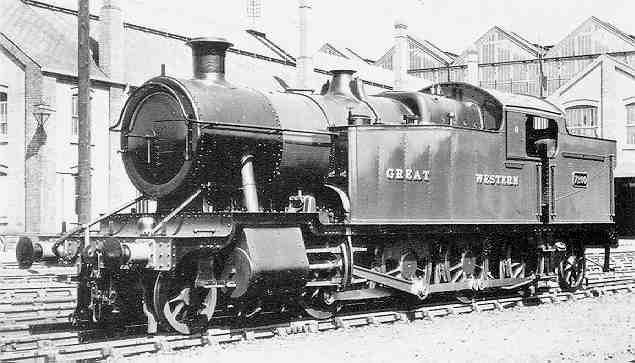 |
7221 and 28 received new cylinders and were given the curved style front ends in the 1950s. The recess to bunker fitted later to at least 7200, 1, 10, 22, 31 and 39.
The situation regarding bunker fenders on 72xx locos – certainly in the first group of original rebuilds – seems to have varied very much from loco to loco and is best checked, if at all possible, by reference to dated photos as some seem to have lasted quite late without fenders and were probably withdrawn without them. See for example, 7202 when new, and 7204 and 7234 in 1960.
In the mid-1950s, several engines in the first group 7200–19 gained the same pattern bunker as the third group 7240–53, i.e. the straight line of rivets. The engines involved can only be ascertained from photos.
There are also photos of 72xx with tall bonnets, e.g. RCTS figs J66 (7215 BR early crest) and J68 (7249 in shirtbutton livery), and Russell vol 2 fig 469 (7240 in 1947). Bonnet types were a particularly changeable feature needing dated photos to be sure.
Great Western power classification and route restriction: E, Red. BR power class 8F.
Livery
The standard GW scheme of Middle Chrome Green, fully lined out (and garter crest) prior to 1916, thereafter unlined green, and, where applied, black as a wartime measure from 1943 to 1945. There is no record of any of the 42xxs receiving the 1917 khaki.
GREAT WESTERN on the tank sides until 1934, then the Monogram followed from 1934 (but see notes on the rebuilt 72xx above), and then by G W R in 1943. There is photographic evidence that 4201, 4211, 5252 and 7200 received the non-standard sans-serif Grotesque font of hand-painted lettering in the mid-late 1940s, presumably following overhaul at Caerphilly.
British Railways – overall black.
References
GWR 8-Coupled Tank Engines, RMweb;
Locomotives of the Great Western Railway Part 9, RCTS;
The Art of Weathering, Wild Swan;
Great Western Railway Journal Nos. 18, 69, 70 & 71;
Collett and Hawksworth Locomotives, Ian Allen;
Great Western Way, HMRS;
A Pictorial Record of Great Western Engines, Jim Russell, OPC;
British Railways Locomotives 1948, OPC;
7200 Trust
| Section Page | Previous Page | Next Page |
